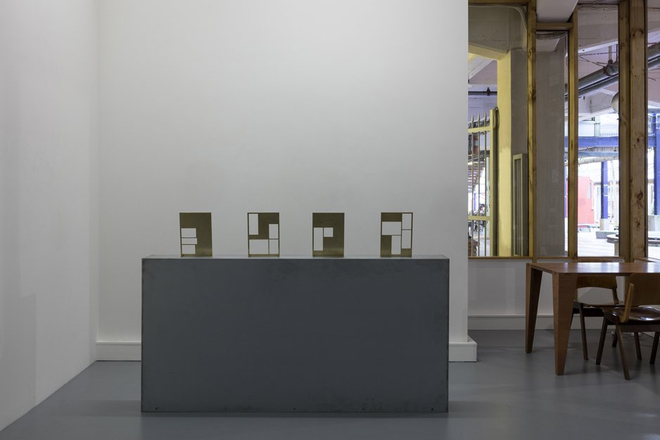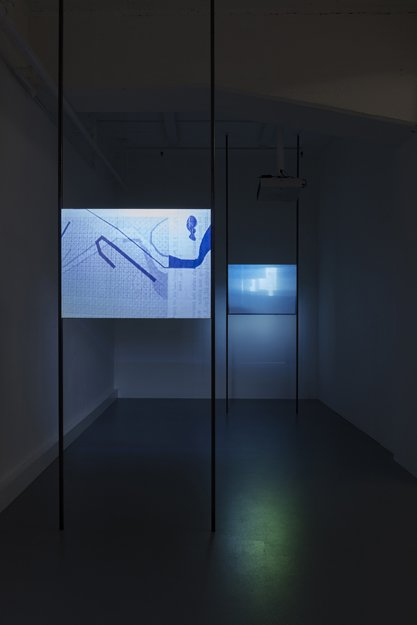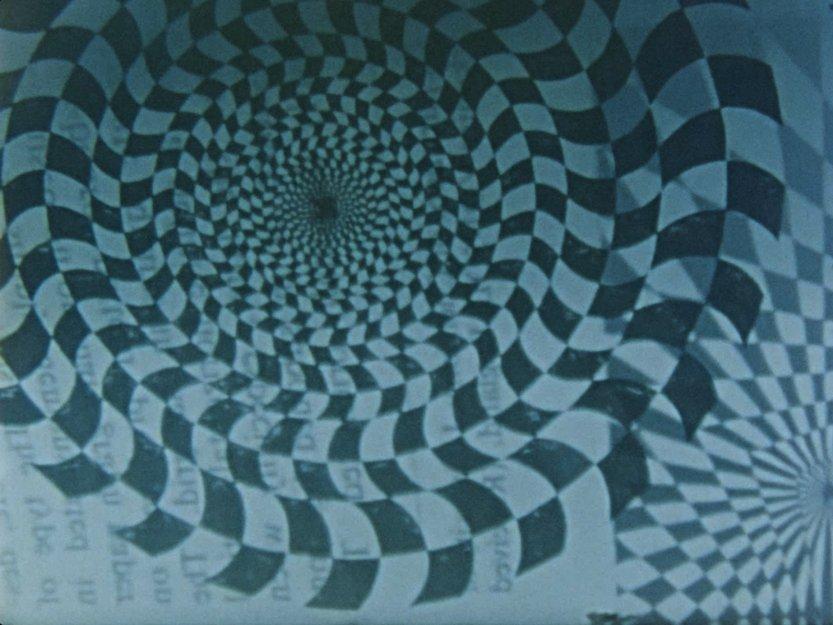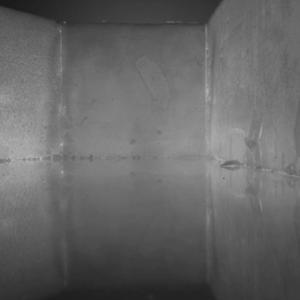It should be obvious enough that the title alludes to a form of synaesthesia, the commingling of senses, so that the idea of a colour might take on the feeling, or a consistency of touch. Then again, we might think of this coarseness as being simply a kind of gradient. Perhaps photoshop makes that too obvious a trove to develop, but the idea that colours take on a textural edge, a roughness, is nonetheless something we ought to be overly familiar with from painting anyway. That palette has always been described in association with its application. From the thickness of impasto, to the luminous tactility of a soft wash, there is a whole language of urgency and vibrancy that revels in the sensory reading of paint. Indeed, to flip tracks, we need only think of Richard Bryant’s Knuckle Tree, those lumpenfold paintings Lacey’s gallerist Robert Heald showed mid-way through last year. There, paint defiantly proposed a texture, none other than that stercorian economy Michel Serres makes so infamous.(1) Yes, that “spitting in ones’ soup”(2) was certainly an acquired palette but it was no less textured, even if it was blatantly so. Indeed, so much so, that you got not so much a textural feeling, a coarseness of touch, of the skin’s mediation with the world, than rather an industrious type of nesting, a synaesthesia of the fold, of a habituating instinct, more like an arousal of sapidity, a rekindling of the dwelling instinct.
A small delay, but that is precisely what synaesthesia does. It takes some sense and makes it another. Makes a home from one instant and tropes it, spins it into another web of feeling, of likeness. To trope is to turn, to turn topos on its head. To spin it around. To mix. Which is precisely what Sonya Lacey’s latest show does. In fact it is very much like an echo chamber, a dalliance with commingled senses. Light refracts. Actually a transmittable image refracts, an image is photographed then made into a sign, a sign that fragments, that spins. You stand in a room full of fragments, of books, of catalogues, images which have been filmed, which have been set in motion. Subjects overlap, one page bleeds through onto another, just as Lacey’s dual screens similarly replicate the process. It is palimpsestic, but it is also method. There is a clarity of the image, and then a mutating of the senses.
This echo is reinforced by the small cut-out sculptures which are housed to the side of the projection on a chest high steel plinth. Named after Muriel Cooper(3), these brass miniatures, replicate the page layouts she pioneered. Fragile, rendered in negative, absent of content, they are pure mechanism. They project a forthright clarity, an intent of purpose and yet they are very much like awards. Like little plaques. Commemorations. Such melancholy is no doubt inflected by Lacey’s Newspaper for Vignelli (2010) where she printed Massimo Vignelli's rejected redesign of a European Journal, and filmed the broadsheet blowing in the wind. Like that tumbling, ambulatory waltz, always falling short of pure legibility, Lacey’s plaques for Cooper are similarly concerned with a prototypical moment of design’s evolution. So much so that standing in her latest exhibition is akin to standing in an echo chamber, momentarily enveloped by reverberation, by the bifurcation of history’s unstoppable asymmetrical flow.

Installation view of Smooth but coarser than yellow (2017) Sonya Lacey. Courtesy of the artist and Robert Heald Gallery
Actually what I wanted to say is that if it is smooth but coarser than yellow, we still don’t know what it is. It’s not yellow. That’s all we know. But then we also know that yellow can be defined by its smoothness. Which is to say we define it by the very property it isn’t; coarse when it is really smooth. In fact all this time I have even been assuming that it refers to another hypothetical colour, but if synaesthesia is truly a mixing up of the senses might it not equally refer to a scent, perhaps to some other hybrid commingling of the senses? Indeed could this coarseness refer to this moment of bifurcation, the moment of design’s evolution that Lacey’s invokes? Or could it be something else entirely. If Bryant’s paintings invoke a sensory dwelling practice might Lacey point similarly to another commingled refrain, a combination of senses we have not yet entertained?
Lacey’s title derives. Something is determined by its relation. This is not the first time she has done this. For instance last year in her Engine Room installation, the show revolved around a number of absent referents, something compounded by the very title of that show, Infinitesimals. As a category, infinitesimals account for quantities that are explicitly nonzero and yet smaller in absolute value than any real quantity. These quantities exist then in a register that is hard to define, it it is a supplemental background that is as withdrawn as it is necessarily supplemental. Fittingly enough, in that show Lacey makes a joke of this register with her short film about the homeopath’s radio which can never not be turned off. What’s important here is the idea of transmission, of being receptive to transmission, so that one takes up a specific disposition, a position even. It is a model of attunement, of being receptive to what is already in play. After all, as Serres points out, position is everything: "to play the position or to play the location is to dominate the relation. It is to have a relation only with the relation itself."(4) Standing amongst the video projections of Lacey’s latest show you can’t miss this relation. On the one hand history’s canonical page layouts are put into motion. Images bleed into each other. History blurs. Its deviations repeat in the images Lacey isolates. Spirals, concentric lines meander, pixelated flows proliferate. There is a general malaise, a funk of information overload, of a signal’s noise. It saturates the environment. It allows transmission to take up centre stage. The Muriel Cooper sculptures become like anchors, waystations of clarity. And yet they are, fittingly, entirely absent of content. They are the scaffolding. The frame. The very method of delivery. They are like Fiona Connor’s abandoned newspaper stands. Dormant mechanisms, residing outside of circulation and yet central to it.(5)

Installation view of Smooth but coarser than yellow (2017) Sonya Lacey. Courtesy of the artist and Robert Heald Gallery
It is often said that all of Michel Serres’ books might be written as a philosophy of the commingled body. Of the senses united to make a sapid human, one no longer dominated by languages’ routines, by cultures’ saturation of the thinking body, of the indoctrinated body, of the interpolated mind. And yet nothing eclipses that stercorian economy. Abuse follows abuse in a downward stream. It is the only unification we know. The only circulation we know. Into the midst of this, Lacey’s show unfolds, like the narrative fragments she weaves, always playing the position, the relation between content. Rekindling circulation, mixing, invoking. This has never been so clear as the moment in Smooth but coarser than yellow when she stops the ambulatory cohesiveness of the films’ melancholic atmosphere, interrupting that signal noise to make a joke about the "preponderance of simile", going on to itemise all those moments in which this is like that.
---

